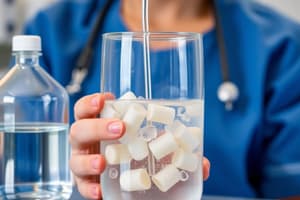Podcast
Questions and Answers
What is the primary function of water in the body's metabolism?
What is the primary function of water in the body's metabolism?
- Production of energy
- Storage of fat
- Absorption of vitamins
- Hydrolysis of nutrients (correct)
Which compartment contains the majority of the body's water?
Which compartment contains the majority of the body's water?
- Intracellular fluid (correct)
- Intravascular fluid
- Extracellular fluid
- Interstitial fluid
What percentage of body weight does water typically constitute in normal adults?
What percentage of body weight does water typically constitute in normal adults?
- 70%–80%
- 80%–90%
- 50%–60% (correct)
- 30%–40%
Which of these is NOT a function of water in the human body?
Which of these is NOT a function of water in the human body?
What is the main source of water intake for humans?
What is the main source of water intake for humans?
What can a positive fluid balance lead to in the body?
What can a positive fluid balance lead to in the body?
How does water contribute to the human body's acid-base balance?
How does water contribute to the human body's acid-base balance?
What is typically the consequence of prolonged water depletion in the body?
What is typically the consequence of prolonged water depletion in the body?
What is the role of ADH in fluid balance?
What is the role of ADH in fluid balance?
What happens when sodium levels in extracellular fluid are reduced?
What happens when sodium levels in extracellular fluid are reduced?
How does aldosterone contribute to fluid and electrolyte balance?
How does aldosterone contribute to fluid and electrolyte balance?
What is the average fluid requirement for an adult based on calorie consumption?
What is the average fluid requirement for an adult based on calorie consumption?
What is the consequence of excessive water retention in the body?
What is the consequence of excessive water retention in the body?
What primary factor influences the amount of water an adult requires daily?
What primary factor influences the amount of water an adult requires daily?
How does thirst contribute to fluid balance in a healthy person?
How does thirst contribute to fluid balance in a healthy person?
What occurs when sodium is replaced in the extracellular fluid?
What occurs when sodium is replaced in the extracellular fluid?
What are the primary characteristics of pregnancy-induced hypertension?
What are the primary characteristics of pregnancy-induced hypertension?
Which condition is characterized by convulsions, coma, and potential mortality for both mother and infant?
Which condition is characterized by convulsions, coma, and potential mortality for both mother and infant?
What factors contribute to a higher incidence of pregnancy-induced hypertension?
What factors contribute to a higher incidence of pregnancy-induced hypertension?
What is the most common form of anemia?
What is the most common form of anemia?
What does pica refer to in the context of pregnancy?
What does pica refer to in the context of pregnancy?
What is a potential consequence of neglecting to discourage soil ingestion in pregnant women with pica?
What is a potential consequence of neglecting to discourage soil ingestion in pregnant women with pica?
Which of the following is NOT a noted effect of fetal alcohol syndrome?
Which of the following is NOT a noted effect of fetal alcohol syndrome?
Folate deficiency in pregnant women may lead to which condition?
Folate deficiency in pregnant women may lead to which condition?
Flashcards are hidden until you start studying
Study Notes
Fluid and Electrolyte Balance
- The hypothalamus stimulates the pituitary gland to excrete ADH (antidiuretic hormone) or vasopressin.
- ADH causes the kidneys to reabsorb water.
- Thirst causes a healthy person to drink fluids.
- When sodium in the extracellular fluid is reduced, water flows from the extracellular fluid into cells, causing cellular edema.
- Adrenal glands secrete aldosterone, which triggers kidneys to increase the amount of sodium reabsorbed.
- When sodium is replaced in the extracellular fluid, excess water moves back to the extracellular fluid, and edema is relieved.
- The amount of water used varies depending on age, size, activity, environmental temperature, and physical condition.
- The average adult requirement is 1 mL for every calorie of food consumed.
Pregnancy-Induced Hypertension
- Formerly called pre-eclampsia or toxemia.
- Characterized by high blood pressure, protein in the urine, and edema in the third trimester.
- May progress into the eclamptic stage with convulsions, coma, and possible death of the mother and infant.
- Higher incidence during the first pregnancy, multifetal pregnancies, morbidly obese mothers, or those with inadequate diets, especially protein deficient.
Pica
- Pica is the craving for nonfood substances such as starch, clay (soil) or ice.
- Ingestion of soil should be discouraged due to possible contamination and nutrient deficiencies.
- Multiple nutritional deficiencies can result from pica.
Anemia
- Anemia is a condition caused by an insufficiency of red blood cells, hemoglobin, or blood volume.
- Causes weakness, fatigue, poor appetite, and pallor.
- Iron-deficiency anemia is the most common form.
- Folate deficiency may lead to megaloblastic anemia and is prevented by folate supplements.
Alcohol, Caffeine, Drugs, and Tobacco
- Fetal alcohol syndrome (FAS) is characterized by a growth deficiency, central nervous system dysfunction, microcephaly (small head), and other physical characteristics.
- Fetal alcohol effect (FAE) causes fewer physical defects, but many behavioral and psychosocial problems.
Water
- Humans can live about 30-45 days without food.
- Humans can live only 10-14 days without water.
- Water is present in all body cells.
- Water is 50%-60% of the body weight of normal adults.
- The percentage is highest in newborns and decreases with age.
- Two basic compartments:
- Intracellular fluid (ICF): within cells, 65% of total body fluid.
- Extracellular fluid (ECF): outside cells, 35% of total body fluid, found in intravascular fluid, interstitial fluid, and glandular secretions.
- Major component of blood plasma
- Solvent for nutrients and waste products.
- Necessary for hydrolysis of nutrients.
- Essential for metabolism.
- Lubricant in joints and digestion.
- Cools the body through perspiration.
- Provides some mineral elements.
- Drinking water is the best source.
- Other beverages are the second-best source.
- Other sources include fruits, vegetables, soups, milk, and gelatin desserts.
- Energy metabolism produces water.
Studying That Suits You
Use AI to generate personalized quizzes and flashcards to suit your learning preferences.




